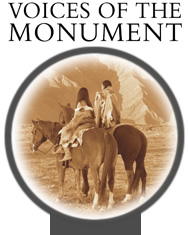Santa Rosa & San Jacinto Mountains National Monument
Language of the Land :
Enrich your visit to the Santa Rosa and San Jacinto Mountains National Monument by learning about the local plants, animals ... and words. Here are some terms you might hear:
ALLUVIAL FAN or PLAIN — A gradually sloping mass of gravel that widens out like a fan. We see them at the base of canyons in the monument. The city of Palm Desert is built on an enormous alluvial fan.
BAJADA — An area where several alluvial fans come together in one big alluvial fan.
VENTURI EFFECT — The effect created when air is constricted through a narrow passage — such as the San Gorgonio Pass — generating strong winds.
OLLA — A type of Indian artifacts sometimes found in the mountains, this is a pot with a narrow neck that was used for storing water or seeds.
MORTERO or MORTAR — A surface once used by Indians for grinding or breaking shells and seeds. You can still see morteros, appearing as deep holes, in boulders. Cahuilla Indians sometimes used wooden mortars, but they generally have not survived as artifacts.
TINAJA — Natural water tank. These deep indentations are found in rocky outcrops along waterways.
ESCARPMENT or SCARP — A steep cliff, as in the north face of Mount San Jacinto.
DESERT VARNISH or PATINA — A dark stain that forms on rocks exposed to sun and rain. The color comes from iron and manganese in the rock.
BIOME or LIFE ZONE — A specialized community of plants and animals whose makeup is determined by soil and climate. There are four or five biomes within the national monument.
CREPUSCULAR — Active at twilight or just before sunrise. Locally, the common Poorwill is crepuscular.
AESTIVATION or ESTIVATION — Passing the summer in a "deep sleep" or dormant state, the hot weather version of hibernation.
WASHINGTONIA FILFERA — The Latin name for the only palm tree native to the southwest desert, this is the palm found in many of our canyons.
